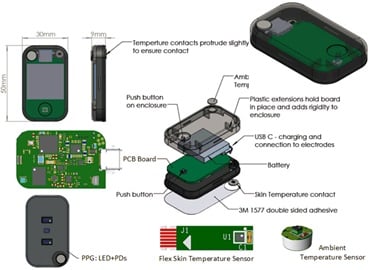The chest patch design helps track vital signs using PPG, ECG, BioZ, and temperature sensors. It allows real-time data analysis, custom algorithms, and wearable health projects.

The MAXREFDES106 Health System Platform 4.0 is a chest patch reference design from Analog Devices (ADI) for vital sign monitoring (VSM). It uses high-sensitivity photoplethysmography (PPG), electrocardiogram (ECG), and bioimpedance (BioZ) sensors, along with temperature biosensors and algorithms, to measure blood oxygenation (SpO2), heart rate (HR), respiration rate (RR), impedance cardiography (ICG), body impedance analysis (BIA), and skin/ambient temperatures. The collected data can be streamed via low-energy Bluetooth to a PC graphical user interface (GUI) for demonstration, evaluation, and custom development.
The Health System Platform 4.0 is suitable for medical device developers, biomedical engineers, healthcare researchers, wearable tech companies, algorithm developers, and universities or research labs working on bio-signal monitoring. It enables testing and development of custom applications for fitness, health, and clinical monitoring by providing a chest-worn reference design with advanced biosensors and signal processing capabilities.
The patch is designed for long-term passive monitoring, running for a day on a single charge. Its PPG system includes a red and infrared (IR) light emitter and two photodiode receivers. The AFE features dual high-resolution optical readout channels with ambient light cancellation, making it suitable for SpO2 measurement. PPG and accelerometer data are processed by the embedded algorithm in the MAX32674C algorithm hub to calculate SpO2.
For ECG monitoring, the system uses three electrodes for continuous ECG and four electrodes for BioZ measurements. The PC GUI includes algorithms for filtering ECG and BioZ data and calculating heart rate, respiration rate, blood stroke volume, and cardiac output. These algorithms are not publicly available, except for the SpO2 algorithm, which is provided as an .msbl file for flashing to the MAX32674C.
The patch also measures skin and ambient temperatures using two low-power, high-accuracy sensors. Real-time vital signs can be viewed and logged via low-energy Bluetooth on a PC GUI running on Microsoft Windows.
The MAX32666 host MCU retrieves raw ECG, BioZ, and PPG data from the MAX86178 AFE and ADXL367 accelerometer, along with raw temperature data from the MAX30210 sensors. It also runs the ‘Location Finder’ algorithm to determine the best placement for the MAXREFDES106# on the chest.
PPG and accelerometer data are processed by the embedded algorithm in the MAX32674C Algo Hub to calculate SpO2 readings. The MAX32674C includes bootloader firmware, enabling updates to the latest ADI-supplied proprietary SpO2 Algo Hub .msbl firmware.
The system features three electrodes for continuous ECG monitoring and four for BioZ measurements. The PC GUI connects wirelessly to the MAXREFDES106# via a BleuIO dongle using BLE. It includes algorithms to filter ECG and BioZ data and calculate heart rate and respiration rate. The GUI also allows users to adjust configuration settings, log data, and view plots for ECG, BioZ, SpO2, respiration rate, accelerometer readings, and temperatures.
ADI has tested this reference design. It comes with a bill of materials (BOM), schematics, assembly drawing, printed circuit board (PCB) layout, and more. The company’s website has additional data about the reference design. To read more about this reference design, click here.







